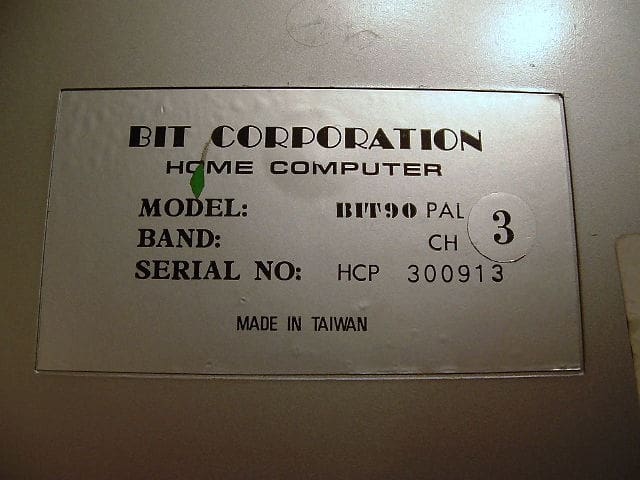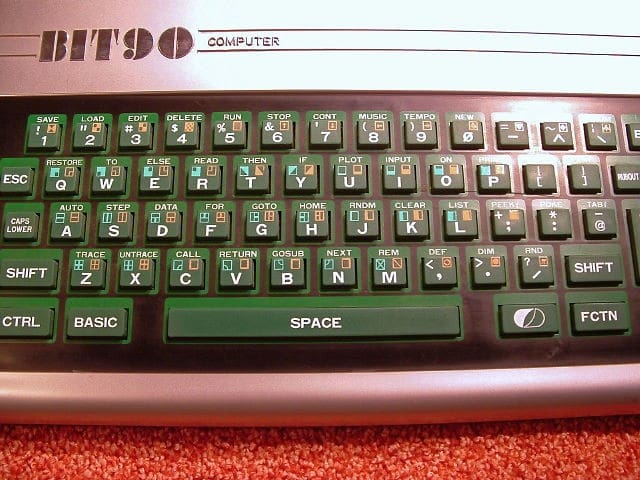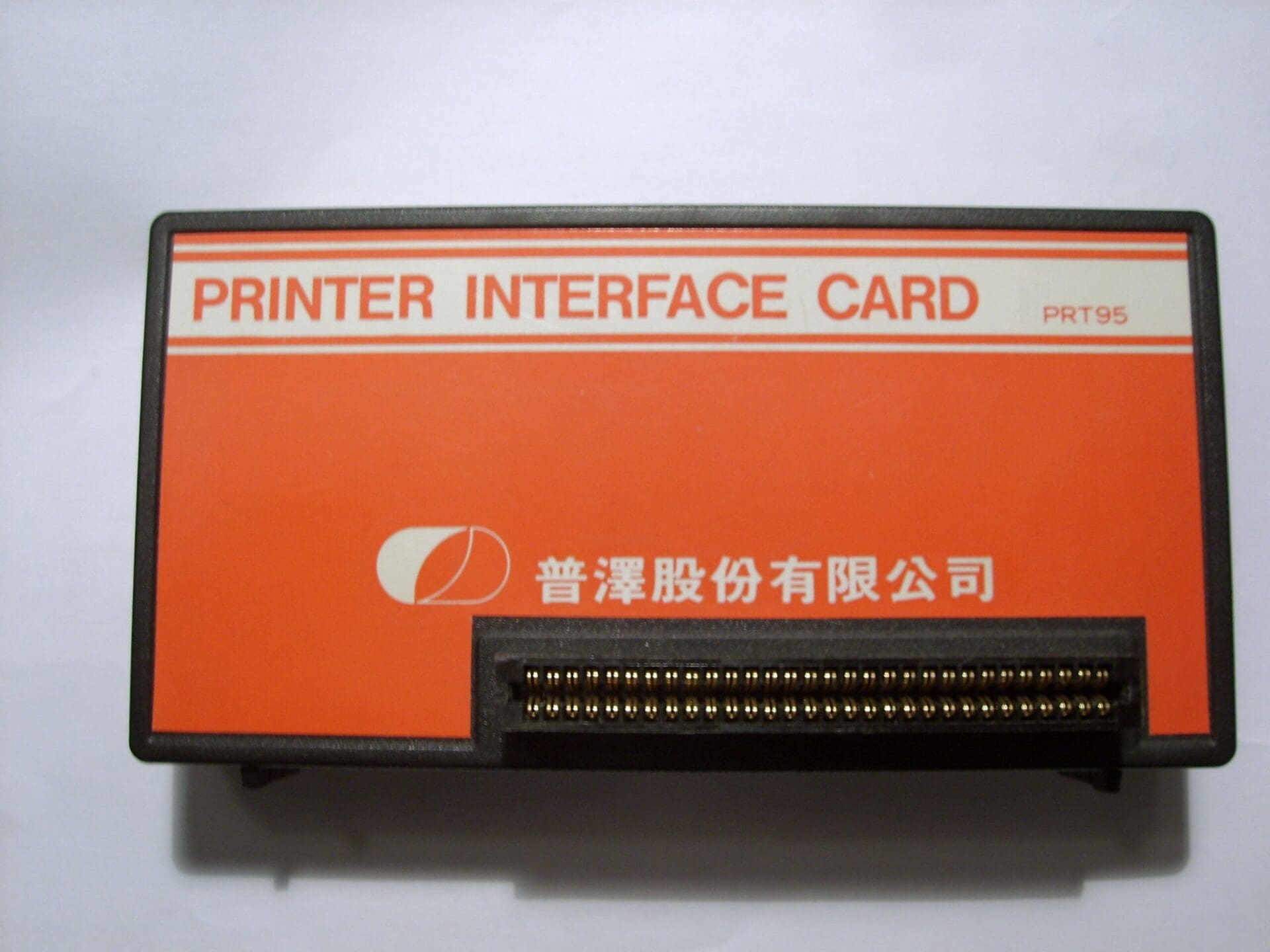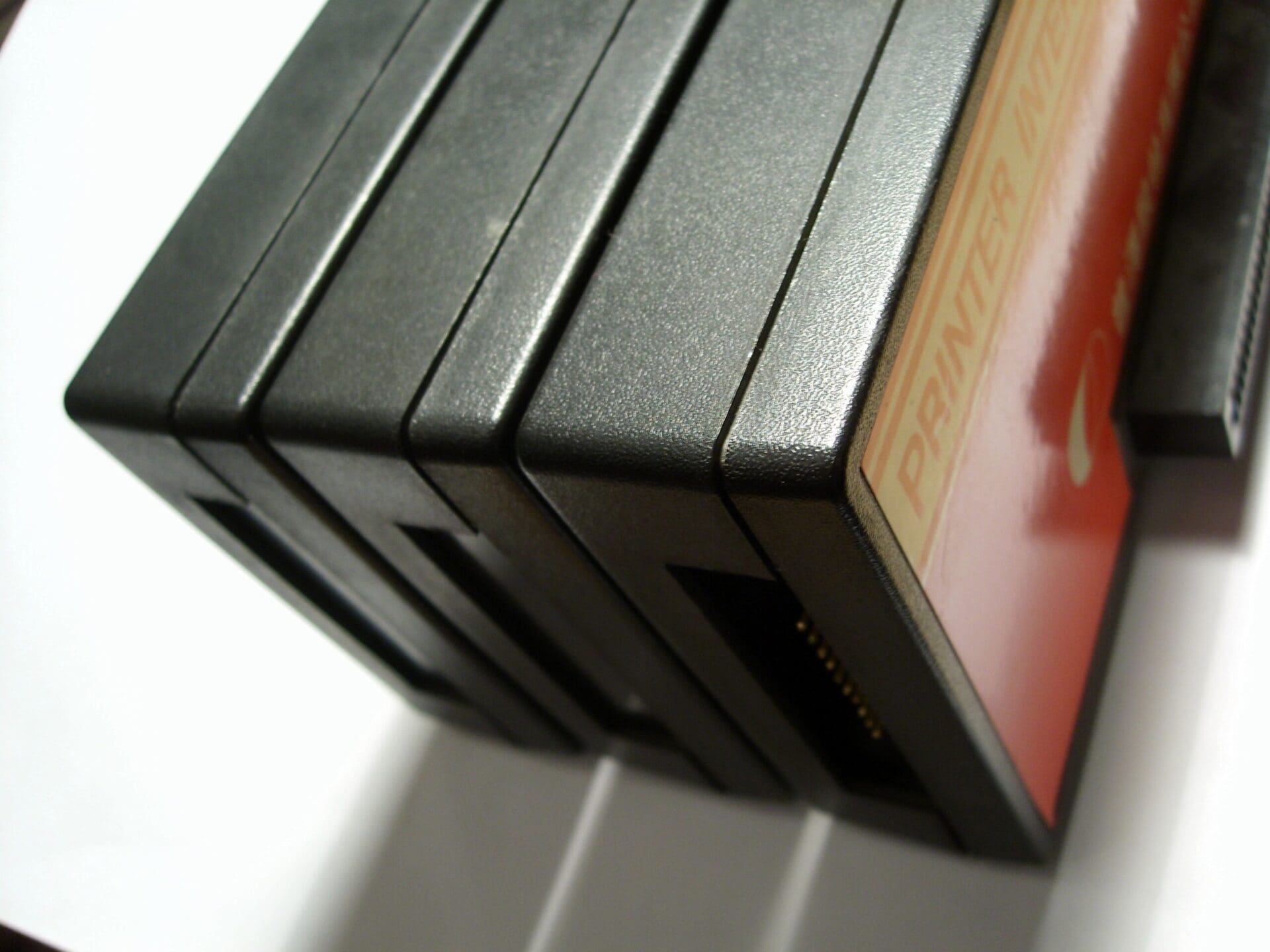The (too) late competitor
The Bit Corporation Bit90 has the disfavour of late birth. When it was launched in 1984 by the Taiwanese company Bit Corporation, the C64 already showed what a successful computer should look like.
The ingredients for a million-seller in the Orwellian year were certainly no memory of puny 18 KB and a (albeit superb!) rubber keyboard. In addition, there was the steep price of about 600 DM with 34 KB RAM (or 500 DM with 18 KB RAM).
The Commodore 64 was not much more expensive at that time with 698 DM, but much better – in pretty much every respect. Converted to today’s (2021) prices, you have to compare the Bit 90 with a good PC:
18 KB version: 750 Euro
34 K version: 895 Euro
Commodore 64: 1.400 Euro!
You could also calculate this with other devices: Click here for my purchasing power calculator.
My device
I got my device by chance in 1989. I drove my brother to a buddy’s company. There, on one of those then-common “designer” steel shelves, were a Sinclair QL (with manual and a bag full of microdrives!) and the Bit90 with expansion cards.
Both devices were familiar to me and even then I had the urge to collect devices I liked, even if I couldn’t actually use them. What had I paid? I’m not sure any more, but I think it was 20 DM. No kidding.
Well, both of them were already completely unfashionable at that time and my brother’s buddy didn’t care about the money, he just wanted to get rid of the stuff. I think they knew each other from some kind of loose Schneider CPC 464 “club”.
Design
Now I’ll go a bit further: For me, the Bit90 is the MacBook Air among home computers.
What the Bit90 also has in common with the MacBook Air is that it would probably fit in one of those office mailing bags. Or not. :-)
Only the Enterprise 64/128 might be a bit flatter, but it doesn’t reach this elegant self-evidence by far.
As chic as the device is, it doesn’t feel very valuable. Especially the low weight is disappointing. Unfortunately, the silver edges quickly wear off, so the device loses its beauty over time.

Dimensions: 330 x 214 x 50 mm (WxDxH) 66 keys, separate cursor block


Made in Taiwan – yes, but how many were produced? Is my device really only the 913th? Or were there more than 300,913 in total after all? I think there must have been half a million devices in the end. That’s not very much.
Software?
It’s a pity that the device wasn’t a bigger success because the Bit90 offered an interesting additional function: A complete compatibility to the well-known video game Coleco Vision!
Of course, this limited the resolution and colour depth to 256×192 pixels with 16 colours, but this still put it in the lower midfield of the competitors in 1984. The CPU line was also ok, a Z80A clocked with 3.58 MHz acted as the heart of the Bit90, which also allowed the execution of CP/M programs.
Well, the Commodore 64 was not the intended opponent of the Bit90 because the Bit Corporation was actually at home in the console business. This company produced games for the Atari VCS and the NES from Nintendo. One of the games also known in this country was “Bobby geht heim”, which was distributed by “Quelle”.

Oh! A design flaw above the Coleco slot (wire bridge). But well, if you look at the first Atari ST, which had felt dozens of these wire bridges, you can safely turn a blind eye here. This brings us to the inner workings.
Inner life
The Bit90 was actually an upgraded game console – just like its predecessor, the Bit60. This one was “only” compatible to the Atari VCS 2600, but also the Bit90 can be made VCS compatible by an adapter.
For me personally, this adapter and a Bit60 represent the holy grail. This is hardware that absolutely appeals to me.
A Bit60 is a more than interesting device. If you think of the grotty computer expansion for the Atari VCS, which was also distributed by “Quelle”, the expectations go absolutely down the drain.
But when I look at the successful and quite powerful Bit90, I can hardly believe that the Bit60 should have been an absolute zero number. Only… the VCS was not a device for which the developers liked to write software – quite the opposite, as one hears.
Well, the Bit90 is actually a game console, yes, and is there nothing else?
Yes, there is, first of all the grandiose design: Dark green keys, black edging and housed in a flat, silver case. And the nameplates in chrome. That’s really something! And I have to say to all rubber keyboard haters: I haven’t had better keys of this kind under my fingers yet.

Hardware
The inner values were quite remarkable, they corresponded to the Coleco Vision, which probably offered the best arcade games implementations at that time: Zilog Z80A (Z8400A) CPU with 3.58 MHz 24 KB ROM 18/34 KB RAM
TMS9929 graphics unit (known from the TI 99/4a and the MSX calculators) AY-3-8910 sound generator (among others also in: arcade machines, CPC series, Spectrum, ST).
The “crooked” RAM is because the device counts the video player (TMM2016AP) of 2 KB RAM. The graphics chip could use up to 16 KB of dedicated video RAM. However, only the mentioned 2 KB of RAM installed for this in the Bit90.
Graphics: 256 x 192 (64 x 48 LoRes) pixels (32 x 24 characters, ), 16 colours, 32 sprites (monochrome). 34 layers (planes); characters, background, and frame could take 16 colours each.
Sound: three voices, frequency adjustable in 1024 steps. Volume adjustable in 16 steps. One envelope generator, de-/activatable for single voices. Random/noise generator. The sound chip is generally capable of outputting a stereo signal, since the ColecoVision didn’t offer stereo sound either, it’s missing here too.
The device has a real reset button and a wobbly power button (again, this was not always a given with the competition). Some testers reported that the device got too hot after a few hours and crashed.

The Taiwanese know their trade: the clean construction of the Bit90 inspires. You can guess why even today most notebooks manufactured in Taiwan.
BASIC
The really extensive BASIC hardly left anything to be desired. Even if you could call up all commands via shortcuts on the keyboard, as usual with e.g. Sinclair, this was only a bonus and not a duty, since the commands could also be typed in as usual.
This is all great. But unfortunately, there is only one line editor and the BASIC is really not the fastest. There are no graphic commands like Line or Circle, but since you can address every single pixel with the plot command, you have to make your own short graphic routines.
Who the manufacturer of the BASIC is, remains in the dark, but as usual at that time it might be Microsoft. The CPU suggests a MBASIC, but the commands all correspond pretty much to the TI 99/4a, with which the Bit90 also shares the graphics unit.
Commands: auto, abs, asc, atn, bye eof, call, chr$, clear, close, cont, copy, cos, data, def, delete, dim, edit, else, end, exp, fn, for, fre, gosub, hex$, home, if, in, inkey$, input, inscr, int, joyst, left$, len, let, list, ln, load, log, mid$, music, next, new, on, onerr-goto, open, option-base, out, peek, plot, play, poke, pos, print, read, randomize, rec, rem, renum, restore, resume, return, right$, rnd, run, save, sgn, sin, spc, sqr, step, stop, str$, tab, tan, then, tempotrace, to, untrace, val, wait This list makes the C64 fanboy’s jaw drop while his pants open. Isso!
Connections
Here, too, you can’t really complain! At first glance, the connections seem to be complete. In fact, however, one significant connection is missing: the one for a disk drive! Rumour has it that there is actually an expansion card that would retrofit this (with which connector?).
The printer port, which is also missing, is quite common, or was included in the price of 600 DM.
Coloeco-Vision compatible module slot 2x 9-pin standard joystick sockets
Expansion port (proprietary, board version)
Cassette recorder (DIN socket, 2400 baud)
Audio output (DIN socket) RGB character connector (DIN socket)
The Bit90 came with a monitor, a cassette recorder, a TV coax cable, an external power supply (not ColecoVision compatible!) and a quite usable manual. A home computer of that era comes with an RGB(!) monitor output?
Is CP/M compatible? Wow! And has a rubber keyboard on the other side? Okaaaay…? :-O Just for classification, CP/M compatibility was something like DOS compatibility at that time because it enabled the use of thousands of professional programs.
An adult buyer simply expects a more usable keyboard and more than the 32 x 24 characters per screen that the poor Bit90 could only offer. But let’s be honest: What did 95% of the C64 owners use the 1541 disk drive for? To load games with it! Well, most games for the Bit90 were available on module. Coleco Vision modules!
Extensions
There were also several expansions for the device. Among them of course also urgently needed memory expansions. All modules could be plugged into each other(!), so you could use several expansions at the same time. A great thing that C64 owners could only dream of at that time.




Available should(!) be the following extensions:
- 16 KB RAM – up to maximum 32/48 KB RAM total system memory
- 32 KB RAM – up to max. 48/64 KB RAM total system memory
- Centronics
- Floppydrive
- Assembler module (for the module slot?)
- Light pen expansion
- VCS expansion
- RS323C
- Modem
- Userport
How many cards could be plugged in one after the other? Well, at least four or five essential modules ((2x)RAM, floppy, printer, modem) should run together, if the power supply is sufficient and the modules don’t get into each other’s way.
But an IBM PC at that time usually had only one 8-bit ISA bus, which also had to share the bandwidth. The interesting thing about the expansion cards is that they were not hobbyist solutions without a case, as is often the case with C64, and that they can be plugged in one after the other. Furthermore, here hats off and bow to the Bit Corporation, which developed a really thought-out total system.
Conclusion
Target groups:
Well, what were the folks at Bit Corporation thinking with this device (and the Bit60 before it)? They hoped that they could attract as customers the people who already owned a Coleco Vision (or with the VCS expansion: an Atari 2600) and who now wanted to switch to a home computer after the video game crash the year before. Wow! That was millions of potential customers! Then there was the CP/M compatibility, which promised professional use! What a market, what opportunities!
Reality:
But unfortunately, it didn’t work, or only to a limited extent because on the Commodore 64 the pirate scene was already raging in 1984 with distribution centres in all nationwide school yards. What is cooler than an old module that you have on the shelf?
Right! A pirated cassette or disk full of the latest games!
Well, in 1984 the cheapest floppy disks still cost about five DM, but mostly 7.50 DM upwards, which was costly with pocket money of let’s say 20 or 25 Euro per month. But on such a disk you could fit four or five games, sometimes even more.
Financiers:
At that time, the Commodore 64 had the (untenable) reputation of being useful for school with the grandparents, the financiers, so children and parents mostly wanted a C64 and that already decided the race.
Reasons for failure:
Coleco compatible, CP/M compatible – so the software offer for this computer can only be called excellent, without discussion! With extension, one could also still Why did the device fail then?
It was like many other good products, which could not compete with worse products on the market: Ford Edsel, Betamax, Video 2000, Motorola ROKR, DAT, MiniDisk – the list could be continued for a long time, but the worst product, which inexplicably spread too far, was probably „Windows“.
Actually, this is already enough as a reason, because people are rather stupid in the mass, than that they would form a swarm intelligence.
Copycat:
A few years later, Commodore followed the same line of thought with the C65, thinking it would be a neat idea to launch a beefed-up 8-bitter (the fastest of its time) that customers could just swap out for the ol‘ C64 and keep all the peripherals.
In the end, there was less C65 than Bit90. That’s how it can go. But we should also briefly take a moment of remembrance for the Enterprise 64/128, also a great device that found far too few customers. ;-)
Current situation:
Well, all in all, the Bit Corporation Bit90 is actually a dream device, which unfortunately failed to be successful. But today it is a really nice collector’s item, which appeals to console and home computer enthusiasts alike, which is also reflected by the price development lately.
Annotation: This article has been written as the first “filler” article for the HomeCon website, which went live for the first time the next day. I founded HomeCon together with Holger Groh. A few weeks later, the first HomeCon took place in my former place of residence, Seligenstadt, with an overwhelming success.